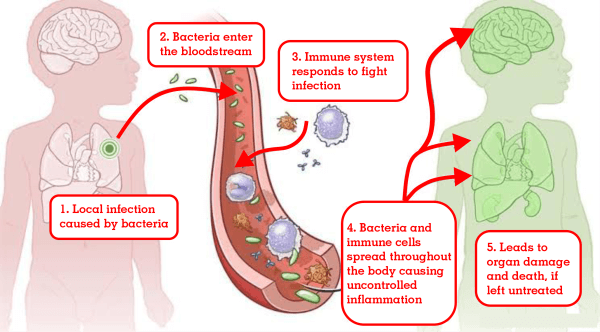Blood InfectionBlood Infections can be defined as the poisoning of blood which may be caused due to bacteria or a virus. When individuals think of blood infections, they probably think of sepsis, which can prevent the body from fighting infection and lead to death if not treated immediately. Moreover, sepsis is not the only condition that can affect the blood. Due to the body's extensive vascular system, blood infection has major consequences. The immune system reacts by releasing an unusually large amount of chemicals that affect the entire body. This emphasises the critical importance of timely and effective blood infection treatment. 
Bloodborne pathogens, such as HIV, and hepatitis can cause diseases and infections and can be transmitted through contact with an infected person's blood or body fluids. Since these infections and illnesses are difficult to treat, it is crucial to know what causes them and how to minimise them. Some common Blood InfectionsCoronary Artery Disease: In this kind of infection blood flow is reduced in the arteries of the legs as a result of peripheral arterial disease. Plaque accumulation in the arteries is typically seen in such medical conditions. Arteriosclerosis: It is accompanied by plaque accumulation in the blood arteries hardens and calcifies in arteriosclerosis. Less elasticity in the arteries increases blood pressure, and the risk of stroke, heart disease, and kidney failure. Chest pains: It is often referred to as myocardial infarction. In this heart muscle tissue dies when the blood supply to the heart muscle is obstructed during a heart attack. Angina: It is a medical condition in which the heart muscle isn't getting enough blood when an individual is suffering from angina. This results in chest discomfort, exhaustion, motion sickness, and shortness of breath. Mitral valve issues: With mitral valve disorders such as mitral valve prolapse, stenosis, or regurgitation, oxygenated blood in the heart flows backwards or blood flow is interrupted. Dysrhythmias or Arrhythmias: In both of these it leads to an abnormal heart rate. Ischemia: Muscles with ischemia receive an insufficient supply of oxygen because of inadequate cardiac blood flow. Aortic illness: An aortic aneurysm is one disease in which the aorta is weak and swells up outward. It is affected by a combination of diseases. Blood Infection (Sepsis)
Sepsis is the most common type of blood infection, defined as a serious complication of septicemia. Sepsis is characterised by widespread inflammation/swelling throughout the body. This inflammation can cause blood clots and prevent oxygen from reaching internal organs, resulting in organ failure. The septic shock takes place when inflammation occurs with extremely low blood pressure. Septic shock is often life-threatening. Cause of SepsisThe major causes of sepsis include:
The foreign pathogen may enter the body through a wound or surgery. An infection with bacteria, a virus, fungus, or protozoa can cause sepsis to develop. Anywhere in the body, such as the bladder, the belly, the chest, or even the skin, can experience an early infection. In sepsis, a significant inflammatory response brought on by the body's immune response to the infection worsens the situation rather than improving it. If not treated immediately, this can lead to organ damage which can lead to organ failure, septic shock, a sudden drop in blood pressure, and even death in extreme conditions. SymptomsThe person suffering from sepsis develops the following symptoms:
Sepsis can also end up causing:
Risks associated with Sepsis
The major group of People at risk of sepsisAfter a wound or small infection, anyone can develop sepsis. However, some people are more prone, such as:
Treatment of SepsisA doctor would provide immediate care. It includes the following treatments:
High-age group people should also take care:
DiagnosisThe doctor makes a diagnosis of Verified Source sepsis by:
PreventionSepsis risk can be decreased by taking precautions against infections and promptly treating if any occurs. In addition, the following measures must be taken:
Next TopicCocci bacteria
|
 For Videos Join Our Youtube Channel: Join Now
For Videos Join Our Youtube Channel: Join Now
Feedback
- Send your Feedback to [email protected]
Help Others, Please Share










